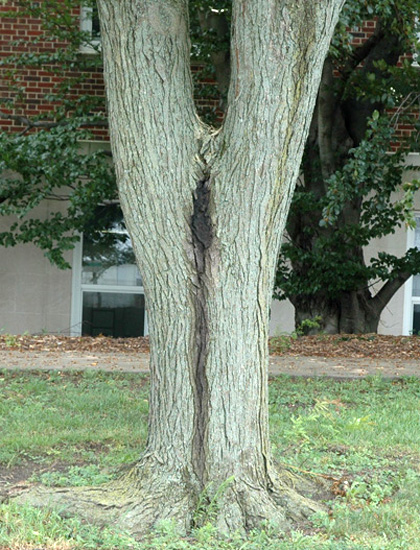Issue 9, June 18, 2010
Wetwood
Wetwood is a condition caused by bacteria that enter wounds in a tree. Although you see the oozing, wet areas coming from cracks in the wood, the bacteria usually enter wounds in the roots. Other than sound horticultural practices, you probably cannot do anything to stop the condition. Elms, poplars, cottonwoods, oaks, and maples seem most commonly affected in Illinois, but many other tree species are susceptible. Enterobacter cloacae (formerly known as Erwinia nimipressuralis) and other bacteria are associated with this disease. This condition in trees is very noticeable by the homeowner because infected trees often have seepage coming from a major crotch or wound in the trunk. The odor associated with wetwood is the result of fermenting bacteria. Wetwood is a chronic, rarely serious, disease of landscape trees that can contribute to general decline in tree vitality but is not known to cause tree death.
Wetwood is most visible externally as a bubbling seepage of bacteria and toxins from wounded tissue in V-shaped branch crotches, pruning wounds, injection holes, and trunk cracks, as in the image. Liquid often runs down the trunk, leaving a white stain. You cannot always see the wound, but you can see the liquid. Bacteria in the inner sapwood and heartwood of the tree ferment causing internal gas pressure. This pressure commonly reopens old wounds and the sour liquid flows down the bark. As it dries, a light gray to white encrustation remains. This encrustation is called slime flux. The liquid commonly causes localized death of the cambium. Interestingly, the anaerobic nature of wetwood and the toxicity of the liquid usually prevent wood rot in that area of the trunk.

There is no cure for this condition, but the following may be helpful. Fertilize stressed trees in the spring or fall to stimulate vigorous growth. Some people like to install perforated plastic or iron drain tubes in the tree to relieve the gas pressure and to allow continual drainage away from the trunk. The idea is to keep the liquid off the trunk so that the cambium is not killed. Be aware that drain tubes often make the problem worse internally. Trees have the ability to compartmentalize injuries or diseased wood. They may "wall off" the wetwood areas. Since drain tubes create a deep wound, they may also break the compartment that the tree has made to encompass the wetwood. This process may allow the internal discoloration and any future decay to spread outside the contained area. Removing dead or weak branches, plus promptly pruning and shaping bark wounds is helpful. These measures will encourage rapid callousing of wounds. The sap flow that results from pruned branches is normal and is not the same as wetwood flow. The liquid we see with wetwood may flow year-round and is often followed by the foul smelling slime flux described.
Consult RPD No. 656, Bacterial Wetwood and Slime Flux of Landscape Trees for more on this condition.--Nancy Pataky
Author:
Nancy Pataky